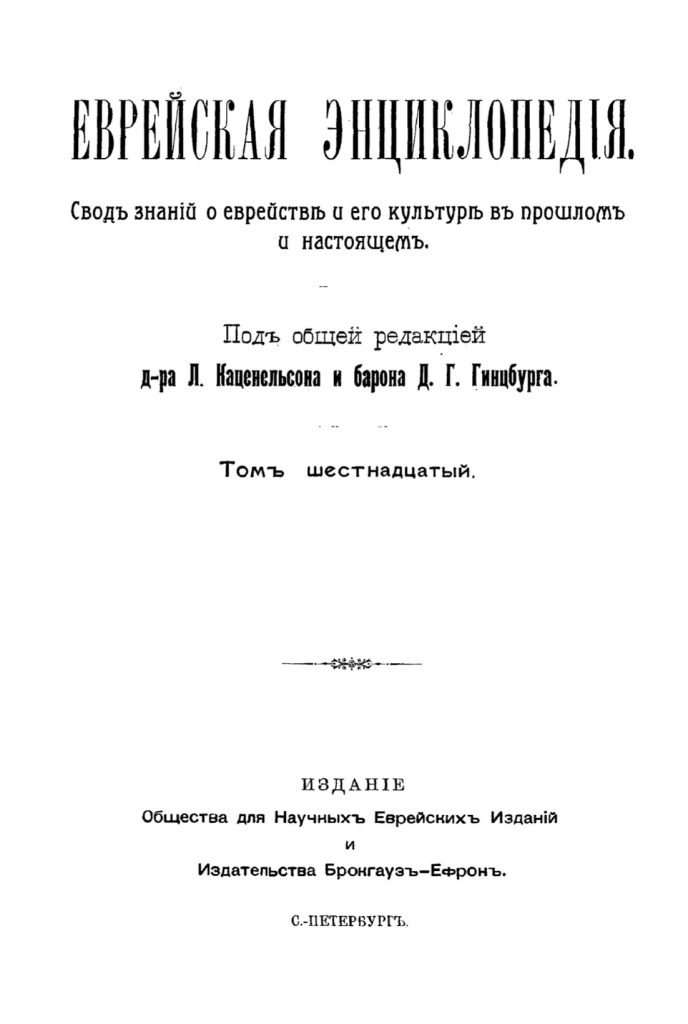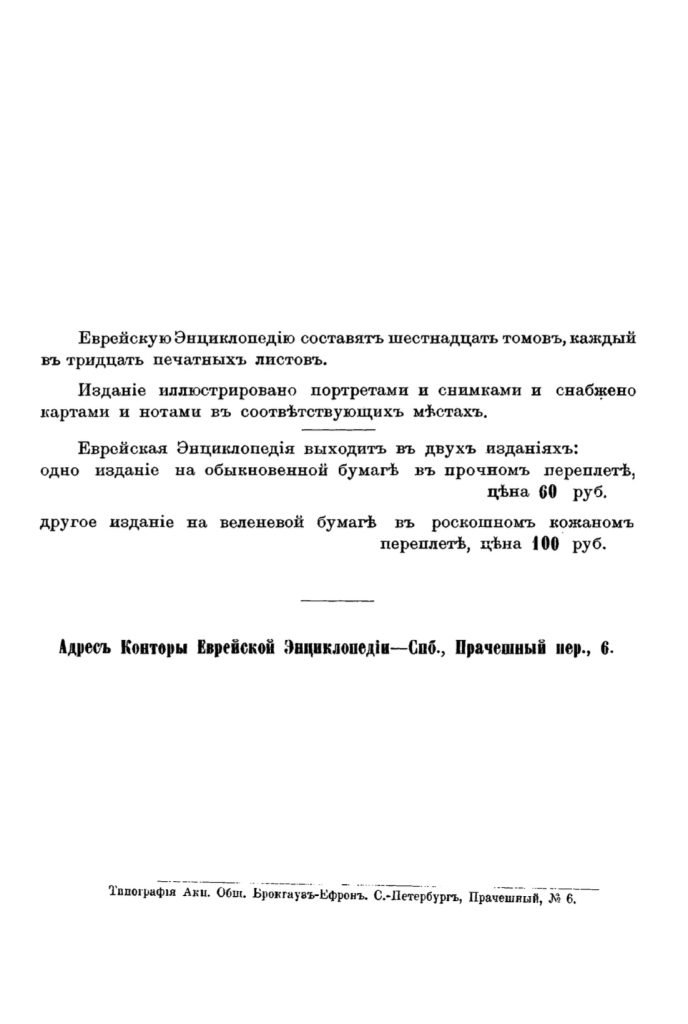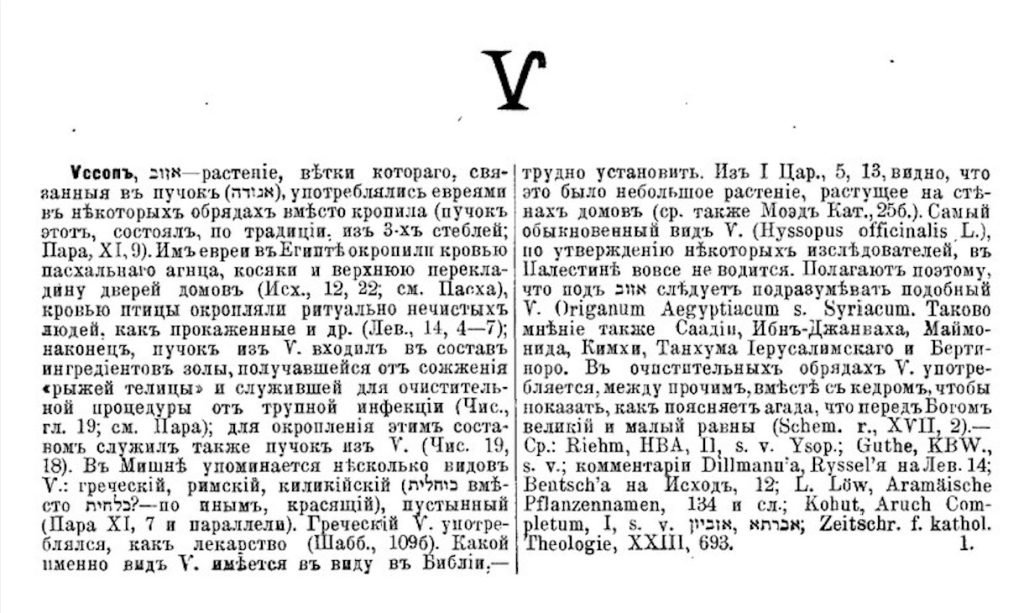Еврейская энциклопедия Брокгауза и Ефрона
The Brockhaus and Efron Jewish Encyclopedia is the first encyclopedia published in the Russian Empire dedicated to “Jewish knowledge and culture in the past and present” (Сводь знаній о еврействі и его культурь вь прошлоь и настоящеь).



The Jewish Encyclopaedia is comprised of 16 volumes of 30 printed folios each.
The publication is illustrated with portraits and photos and has maps and notes in appropriate places.
The Jewish Encyclopedia is published in two editions: one edition is on plain paper with a durable bindin; the price is 60 rubles. The other is on felen paper with a lavish leather binding with a price of 100 rubles.
Address of the Office of the Jewish Encyclopedia: St. Petersburg, Pracheshnyi Iier, 6.
The encyclopedia was published in 1908–1913 in 16 volumes in St. Petersburg by the Society for Scientific Jewish Publications and Brockhaus-Efron Publishing House. It was based and modeled on the 12-volume Jewish Encyclopedia (London; New York, 1901–1906) published a few years earlier.
However, its material was significantly supplemented and expanded by the authors of the Jewish Brockhaus Encyclopedia in everything related to the history, culture and current situation of Jewish communities in Eastern Europe. Work on the Jewish Brockhaus Encyclopedia was contributed by prominent representatives of Russian Judaica, Hebraistics and Oriental Studies: A. Garkawi, D. Gunzburg, Yu Hesse, S. Dubnov, I. Markon, N. Pereferkovich.
The Brockhaus Jewish Encyclopedia still remains one of the most important sources of reference information and statistics on the almost six million Jewish population of the Russian Empire at the beginning of the 20th century. Therefore, its data can be attributed to the valuable sources of information on socio-political, ethnic, cultural and religious history and historical demography of Russia and its neighboring countries.
The Jewish Encyclopedia was not reprinted during the Soviet era. In 1991, the Terra publishing house carried out a reprint of the Encyclopaedia, which can be found on the websites of the following:
Russian State Library (Российская Государственная Библиотека)




Wikisource (Викитека) and Wikimedia Commons

Brockhaus and Efron Jewish Encyclopaedia: Volume 1
Brockhaus and Efron Jewish Encyclopaedia: Volume 16
Final entry for Volume 16: Ѵссопь (Hyssop)

Ѵссопь, אֵזוֹב—растеніе, вѣтки котораго, свяванныя вь пучокь (אגודה), употреблялись евреями вь Пѣкоторыхь обрядахь вивсто кропила (пучокьэтоть, состояль, по традиціи, изь 3-хь стеблей; Пара,XI, 9).
Имъевреи взЕгипть окропили кровью пасхальнаго агнца, косяки и верхнюю перекла- дину дверей домовь (Исх., 12, 22; см. Пасха), кровью птицы окропляли ритуально нечистыхь людей, какт прокаженныеи др. (Лев., 14, 4-7); наконецЬ, пучокь изз Ѵ. входиль вт составь ингредіентовь золы, получавшейся оть сожженія «рыжей телицы» и служившей для очистительной процедуры оть трупной инфекціи (Чис., гл. 19; см. Пара); для окропленія этимь составoмь служиль также пучоко изь Ѵ. (Чис. 19, 18).
Вь Мишнь упоминается нѣсколько видовь Ѵ.: греческій, римскій, киликійскій (כוהלית вмѣсто כלחית?—по пнымь, красящій), пустынный (Пара XI, 7 и параллели). Греческій Ѵ. употреблялся, какь лекарство (Шабб., 1096). Какой именно виль Ѵ. имьется вь виду вь Библін—трудно установить.
Изъ I Цар., 5, 13, видно, что это было небольшое растеніе, растущее на стѣнахъ домовъ (ср. также Моэдъ Кат., 256.). Самый обыкновенный видъ Ѵ. (Hyssopus officinalis L.), по утвержденію нѣкоторыхъ изслѣдователей, въ Палестинѣ вовсе не водится. Полагаютъ поэтому, что подь אזוב слѣдуетъ подразумѣвать подобный Ѵ. Origanum Aegyptiacum S. Syriacum.
Таково мнѣніе также Саадін, Ибнъ-Джанваха, Маймонида, Кимхи, Танхума Іерусалимскаго и Бертяпоро. Въ Очпстительныхъ обрядахъ Ѵ. употреблегся, между прочимъ, вмѣстѣ съ кедромъ, чтобы показать, какъ поясняетъ агада, что передъ Богомъ великій и малый равны (Schem. r., XVII, 2).—Cp.: Riehm, HBA, Ц, ѕ. v. Ysop.; Guthe, KBW., s. v.; комментаріи Dillmanц’a, Ryssel’я наЛев. 14; Bentsch’a на Исходъ, 12; L. Löw Aramäische Pflanzennamen, 134 и cд; Kohut, Aruch Completum, І, s. v.; אברתא ,אזביון Zeitschr. f. kathol. Theologie, XXII, 693.
English translation:
Hyssop, אֵזוֹב—a plant whose branches, tied in a bundle (אגודה), were used by Jews in some rituals instead of a sprinkler (this bundle, according to tradition, consisted of 3 stems; Para XI, 9).
With it the Jews in Egypt sprinkled the blood of the Passover lamb on the doorposts and lintel of their houses (Exodus 12:22; see Passover), with bird’s blood they sprinkled ritually unclean people such as lepers and others (Leviticus 14:4-7); finally, a bundle of hyssop was included in the ingredients of ashes obtained from burning “red heifer” and used for purification from corpse infection (Numbers 19; see Para); for sprinkling with this compound also served a bundle of hyssop (Numbers 19:18).
In the Mishnah several types of hyssop are mentioned: Greek, Roman, Cilician (כוהלית instead כלחית?—according to some dyeing), desert (Para XI, 7 and parallels). Greek hyssop was used as medicine (Shabbat 109b). Which specific type of hyssop is meant in the Bible is not clear—it is difficult to establish.
From Kings I: 5, 13, it can be seen that this was a small plant growing on the walls of houses (see also Moed Kat., 256.). The most common type of Hyssop (Hyssopus officinalis), according to some researchers, is not found in Palestine at all. Therefore, it is believed that Hyssop אזוב should be understood to be similar to Origanum aegyptiacum subsp. syriacum.
This is also the opinion of Saadīn, Ibn-Janwaha, Maimonides, Kimhi, Tanhuma of Jerusalem and Bertaporo. In purification rites Hyssop was used among other things with cedar to show as explained by Agada that before God great and small are equal (Schem. r., XVII, 2).—cf.: Riehm HBA II s.v. Ysop.; Guthe KBW s.v.; Dillman’s comments Ryssel on Leviticus 14; Bentsch on Exodus 12; L. Löw, Aramaic Plant Names 134 and following; Kohut, Aruch Completum I s.v.; אברתא ,אזביון Zeitschrift für kathol. Theologie XXII 693.
Note:
“Cp.” is “cf.”, an abbreviation for the Latin word “confer” which means “compare”. It is often used in academic writing to direct the reader to other sources for comparison or further information. In this context, it appears that the author is directing the reader to compare or consult the works of Riehm and Guthe for more information on the topic of Hyssop.
“HBA” and “KBW” are likely abbreviations for the titles of works by Riehm and Guthe respectively. “II” indicates that it is volume two of Riehm’s work. “s.v.” stands for sub verbo or sub voce, which means “under the word” in Latin. It is used to indicate that further information can be found under a specific entry or heading (in this case, Ysop) in the referenced work.
This part of the passage is therefore directing readers to consult specific entries on Hyssop in works by Riehm and Guthe for further information or comparison.
